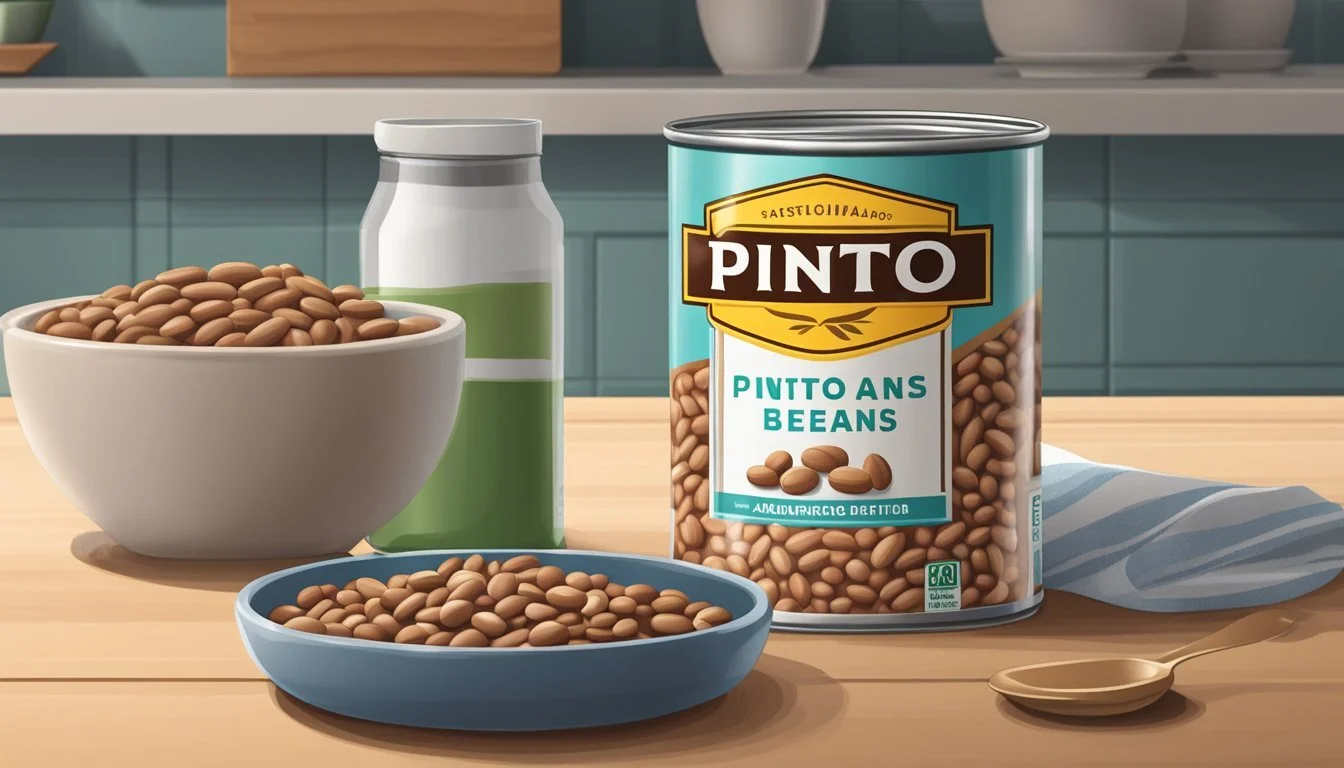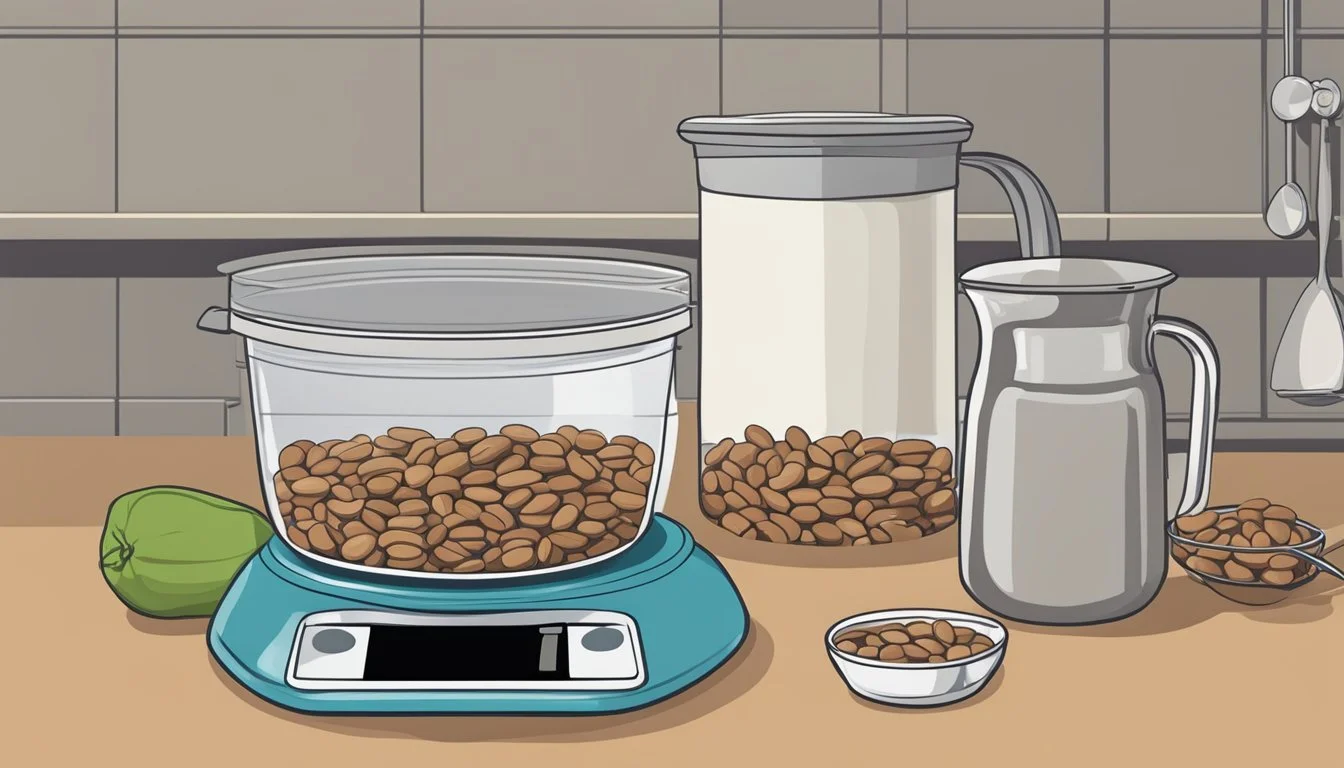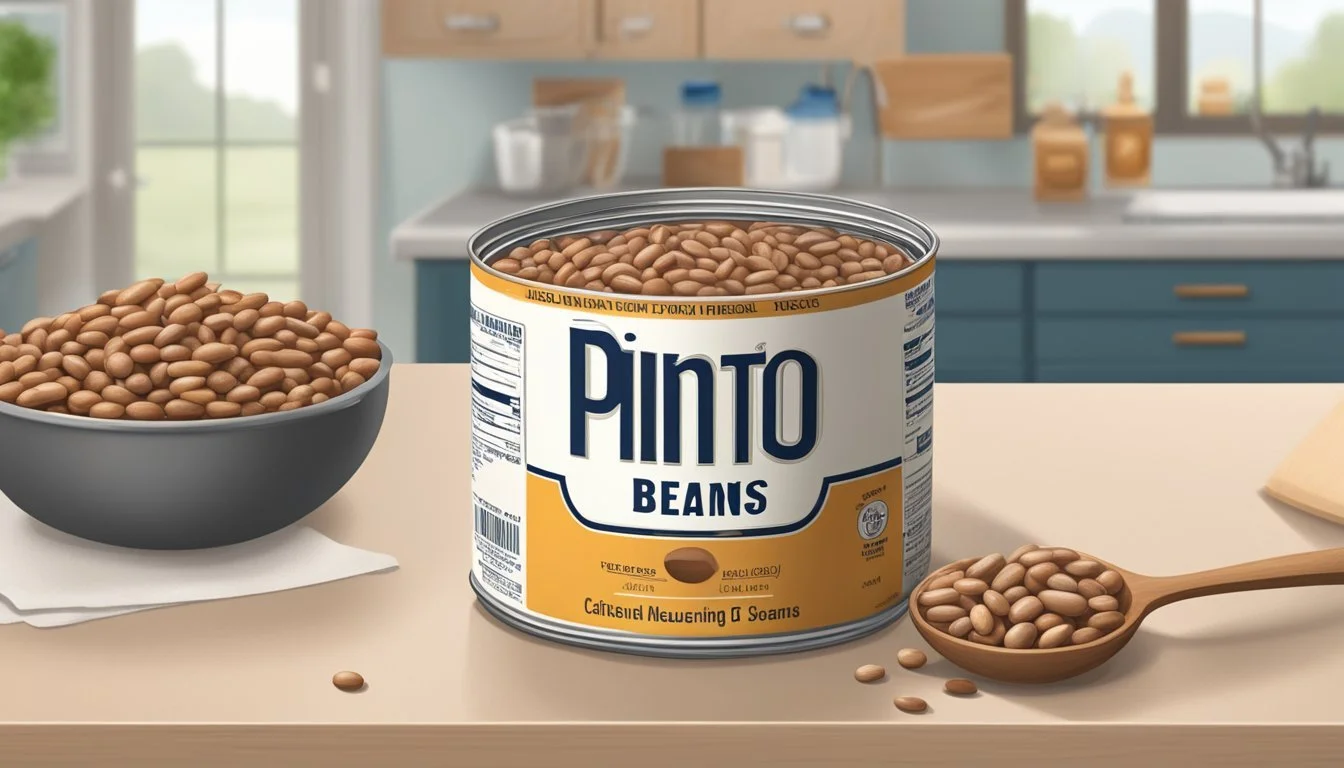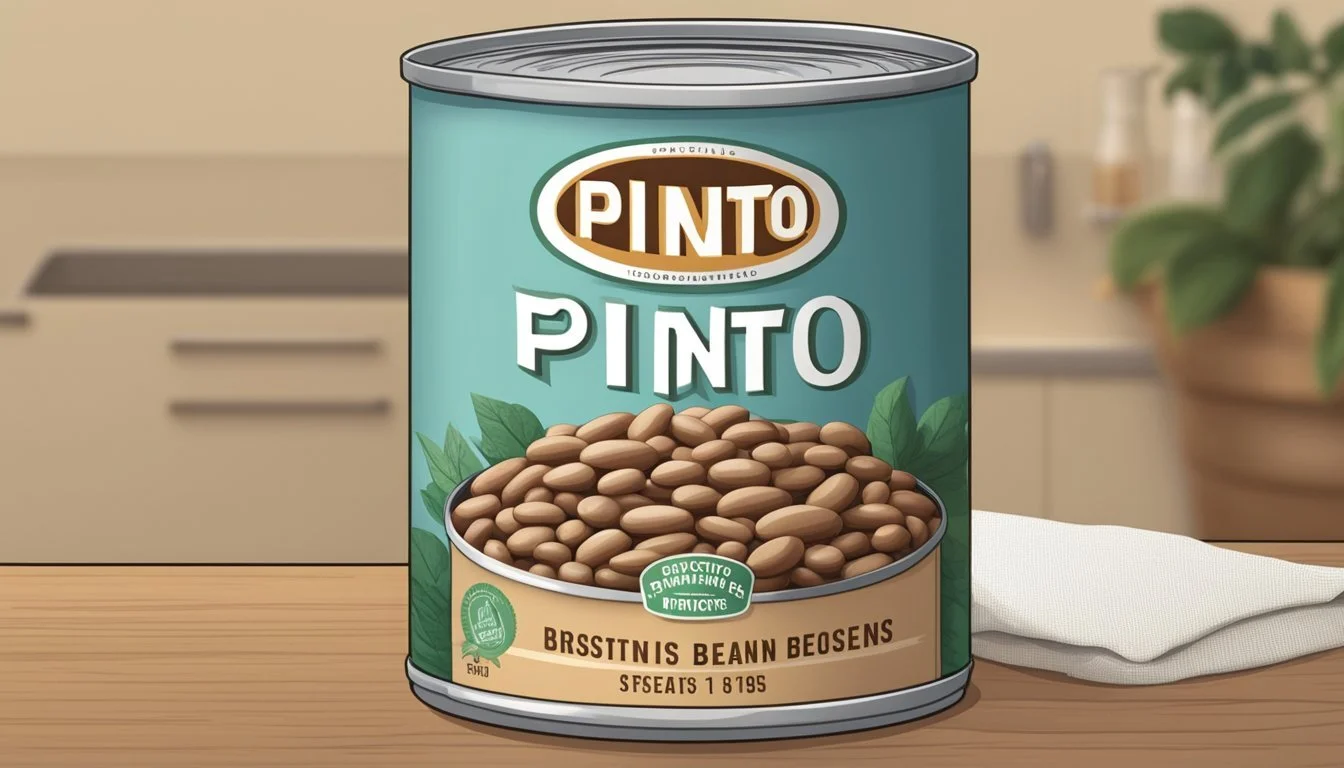How Many Ounces in a Can of Pinto Beans?
Understanding Can Sizes and Measurements
When shopping for canned pinto beans, one typically finds them packed in 15-ounce cans. Pinto beans, a popular type of beans, are a staple ingredient in many cuisines, particularly in Mexican and Southwestern American dishes. One can of these beans generally contains about 15 ounces, or roughly 425 grams, of product. However, once the beans are drained of their packing liquid, the weight of the beans themselves is reduced to about 9 to 10 ounces.
Understanding the weight and the measurement conversion of canned pinto beans is essential for accurately following recipes and managing dietary intake. Nutritionists and chefs alike stress the importance of knowing the contents of a can of beans, as it affects the flavor, texture, and nutritional value of the culinary creation. It is also beneficial for those scaling recipes or converting between dried and canned beans to ensure consistency in the quality of their dishes.
Bean Varieties and Nutritional Profiles
The section delves into the specifics of pinto beans and compares them with other common bean varieties. It highlights their nutritional profiles, including fiber and protein content, essential vitamins, and minerals.
Understanding Pinto Beans
Pinto beans are a staple in many diets due to their beneficial mix of nutrients. A typical can of pinto beans holds about 15 ounces, offering a source of fiber and protein. They are often available in low-sodium or no-salt-added options, catering to health-conscious consumers. The type of pinto bean can affect the texture and flavor, with some being creamier and more earthy in taste.
Comparing Bean Types
When comparing pinto beans to other varieties such as kidney beans, chickpeas, black beans, and lima beans, one can observe variations in taste, texture, and nutritional composition. For instance:
Kidney beans: Rich in iron and have a firmer texture.
Chickpeas: Offer a nuttier flavor and are good for making hummus.
Black beans: Known for their earthy flavor and use in Southwestern and Mexican cuisines.
Lima beans: Provide a buttery flavor and are commonly added to soups and stews.
Each type provides a unique profile of vitamins and minerals conducive to a healthy diet.
Nutritional Benefits
Beans are a nutritious choice with a plethora of health benefits. They are rich in:
Fiber: Important for digestive health and stabilizing blood sugar levels.
Protein: Essential for muscle repair and growth.
Essential vitamins and minerals: Such as iron, folate, magnesium, potassium, and calcium.
A comparison of the nutritional content per 1 cup of cooked beans is outlined below:
Bean Type Fiber (g) Protein (g) Essential Vitamins and Minerals Pinto beans 15 15 Iron, Folate, Magnesium Kidney beans 13 13 Iron, Calcium, Potassium Chickpeas 12 14 Folate, Iron, Phosphorus Black beans 15 15 Iron, Folate, Magnesium Lima beans 9 10 Iron, Folate, Magnesium
Pinto beans and their counterparts contribute markedly to a balanced and nutritious diet. Each offers a distinct sensory experience and an array of health benefits, from supporting heart health to contributing to a reduction in cholesterol levels.
Canned Beans Vs. Dry Beans
Comparing canned and dry beans is essential to understand the convenience, cost, nutritional content, and culinary uses of these two forms of beans. This breakdown will assist readers in making informed decisions between canned and dry pinto beans based on various aspects of usage and storage.
Pros and Cons
Pros:
Convenient, ready to use, and saves time
Consistent texture and flavor
Cons:
Higher sodium content, although low-sodium versions are available
Sometimes more expensive per serving compared to dried beans
Dry Beans:
Pros:
Cost-effective with a lower price per serving
Lower sodium content and the benefit of controlling added salt
Cons:
Require soaking and longer cooking time
Inconsistent texture if not cooked properly
Cooking Comparisons
Canned Beans:
Ready-to-use; only require heating
Limited control over final texture and flavor
Dry Beans:
Soaking can take several hours or overnight
After soaking, cooking time can range from 1 to 3 hours
Texture and flavor can be adjusted to personal preference
Volume and Weight Conversions
For pinto beans specifically, general conversions are as follows:
Measurement Canned Beans Dry Beans (before cooking) 1 cup cooked n/a Approximately 1/3 cup dry 2 cups cooked 1 can (15 ounces) Approximately 2/3 cup dry 3 cups cooked 1 and ½ cans (15 ounces each) 1 cup dry
Canned beans are often heavier due to added water. A 15 oz can usually contains about 9 ounces of actual pinto beans once drained.
Shelf Life and Storage
Canned Beans:
Usually have a shelf life of 2-5 years
Store in a cool, dry place; once opened, refrigerate in a sealed container and use within a week
Dry Beans:
Can last up to 2-3 years or longer if kept in an airtight container in a cool, dry place
Can be cooked and then frozen for extended storage. Frozen cooked beans can last for about 6 months.
Measurement Standards in Recipes
In cooking and baking, recipe success often hinges on precise measurement. Canned ingredients like pinto beans come in standardized sizes, but when recipes call for cups or other measurements, conversion is key. It's important to understand how can sizes translate to weight and volume to ensure recipe accuracy.
Understanding Can Sizes
Can labels often specify the weight in ounces. A standard can size for pinto beans is 15 ounces, which equates roughly to 1 1/2 cups of beans after draining. It's important to note that the listed weight includes liquid, so the weight of just the beans will be less. Manufacturers follow these standards to provide consistency in both retail and recipes.
Converting Measurements
To adapt a recipe using dried pinto beans to one using canned, or vice versa, one must consider the following conversions:
1/2 cup dried pinto beans is approximately equivalent to a 15 oz can.
1 cup of dried beans typically swells to about 2-3 cups when cooked.
Recipes such as chili or soup may require different volumes—a 15 oz can might be perfect for a small batch of chili, while larger recipes may need multiples of this size. These conversions are crucial when adjusting the quantity of beans needed for a recipe.
Dried Beans (cups) Cooked Beans (cups) Canned Beans (oz) 1/2 1 - 1 1/2 15 1 2 - 3 30 - 45 (approx.) 2 4 - 6 60 - 90 (approx.)
Recipe Adaptations
Adapting recipes may require more than just volume conversion. Cooking time and texture can be affected when using canned beans instead of dried. Since canned beans are already cooked, they require less preparation time and are convenient for quick meals. When a recipe calls for a specific size, using these rules of thumb for weight and volume helps maintain the integrity of dishes such as a bean recipe or a chili recipe.
Remember to always adjust seasonings as well, since canned beans may include added salt or preservatives, influencing the flavor profile of your dish.
Cooking Tips and Techniques
When cooking with canned pinto beans, it's essential to consider preparation methods, their versatility in recipes, and techniques to enhance their inherent flavors and textures.
Preparing Canned Beans
Before using canned pinto beans, they should be properly rinsed and drained to remove excess sodium and the thick liquid they are preserved in, as this can affect the taste and texture of the final dish. The typical can size is 15 ounces, with varying cooking times if further heating is required.
Rinse: Place the beans in a colander and rinse under cold water.
Drain: Shake off the excess water to ensure the beans are merely moist, not wet.
Creative Uses in Recipes
Canned pinto beans are a versatile ingredient in the kitchen and can be incorporated into a wide range of recipes. They work well in chilis, soups, salads, and stews, can serve as a hearty side dish, or even be the main ingredient in a bean dip or bean salad.
Bean Salad: Toss rinsed beans with fresh vegetables and a tangy vinaigrette.
Bean Dip: Blend beans with garlic, onions, and spices to create a flavorful dip.
Enhancing Flavor and Texture
To elevate the relatively mild flavor of canned pinto beans, it can be beneficial to cook them with aromatic ingredients such as garlic and onions. Adding corn can introduce a contrasting texture and a hint of sweetness.
Cooking Time: Simmer with chosen seasonings for at least 10-15 minutes to allow flavors to meld.
Flavor: Use broth instead of water and include cumin or chili powder to enhance the taste.
By considering these tips and techniques, one can expertly prepare and utilize canned pinto beans in a variety of dishes, each with a distinct and appealing flavor and texture profile.
Consumer Considerations
When purchasing a can of pinto beans, consumers should be aware of the product's weight, brand reputation, preparation requirements, and cost-effectiveness. Understanding these factors ensures that the selected beans will match the intended recipe and dietary needs, while also providing the best value.
Understanding Labels and Brands
Consumers often face a range of brands offering pinto beans in different sizes and variations. Labels are key to understanding the specifics:
Size: A standard can of pinto beans typically contains 15 ounces, with the beans themselves weighing around 10 ounces after draining.
Variety and Brand: The brand may impact the flavor and texture, as different brands have slightly different processing methods and seasoning levels.
When examining labels, look for terms such as low-sodium or no-salt-added for dietary considerations, and always check the weight listed to ensure it meets recipe requirements.
Choosing the Right Type for Your Dish
The type of pinto beans selected can influence the outcome of your dish in terms of flavor and texture. Options include:
Canned: Convenient and ready to use; ideal for quick meals.
Dried: Requires soaking and cooking but allows for more control over the final texture; best for dishes with longer cook times.
The choice should align with the specific needs of the bean recipes they are intended for. Textural preferences or time constraints will guide this selection.
Economic Factors
Cost is a crucial consideration for many buyers; however, it often correlates with convenience and preparation time.
Dried Beans: Generally cheaper by weight and yield more but involve additional preparation time.
Canned Beans: Higher cost due to convenience factor, but quick to use.
When shopping for pinto beans, comparing prices at various grocery stores and considering the quantity needed can help in finding the most economical option. Purchasing in bulk can also be cost-effective for consumers who frequently use beans in their meals.
Dietary and Health Implications
When evaluating the dietary and health implications of canned pinto beans, it's important to consider their protein content and the broad nutritional benefits they offer. As a versatile legume, pinto beans can be a critical part of a balanced diet for those seeking healthy, nutrient-rich food options.
Beans as a Source of Protein
Pinto beans are a significant source of protein, making them a particularly valuable food for vegetarians and vegans who may seek alternative protein sources to meat. A single can of pinto beans typically contains:
Protein Content: Approximately 21 grams per 15.5-ounce can.
This plant-based protein is crucial for muscle repair and growth, providing the body with essential amino acids. Additionally, the protein in pinto beans can lead to increased satiety, which may support weight management efforts.
Incorporating Beans for Nutritional Benefits
Pinto beans are not only rich in protein but also replete with fiber, vitamins, and minerals, making them highly nutritious. When incorporating beans into one's diet, these factors are essential to consider:
Fiber: A can of pinto beans contains about 18.5 grams of dietary fiber, which can aid in digestive health and blood sugar stabilization.
Minerals: They are a good source of essential minerals such as iron, magnesium, and potassium.
Healthy: Low in fat and containing no cholesterol, pinto beans are a heart-healthy option.
Sodium Content: Canned pinto beans do contain sodium for preservation. Typically, there are about 400 milligrams of sodium per half-cup serving, but opting for low-sodium versions or rinsing the beans can reduce this content.
Due to their health benefits, pinto beans are ideal for those following a nutritious diet, whether one is vegetarian, vegan, or simply seeking a healthy addition to their meal.Understanding Can Sizes and Measurements
When shopping for canned pinto beans, one typically finds them packed in 15-ounce cans. Pinto beans, a popular type of beans, are a staple ingredient in many cuisines, particularly in Mexican and Southwestern American dishes. One can of these beans generally contains about 15 ounces, or roughly 425 grams, of product. However, once the beans are drained of their packing liquid, the weight of the beans themselves is reduced to about 9 to 10 ounces.
Understanding the weight and the measurement conversion of canned pinto beans is essential for accurately following recipes and managing dietary intake. Nutritionists and chefs alike stress the importance of knowing the contents of a can of beans, as it affects the flavor, texture, and nutritional value of the culinary creation. It is also beneficial for those scaling recipes or converting between dried and canned beans to ensure consistency in the quality of their dishes.







